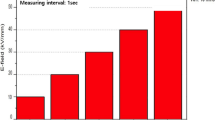Abstract
The main factors that prevent the improvement of the running ability of electrical cables with polymer insulation have been considered. Today, compositions based on polyvinylchloride (PVC) are mainly used as polymer insulation in most electrical cables in Russia. PVC, as are most polymers, is rather sensitive to thermal aging, which is considered as one of the main reasons for the occurrence of various polymer-insulation defects that lead with time to short circuit and fire. It has been shown based on the experimental data that the sewn-in chains of polyene conjugated bonds are formed in PVS macromolecules during the thermal aging. The chains proper are the main reasons for deterioration of the dielectric properties of PVS insulation. The incorporation of conventional plasticizers like phthalates, phosphates, etc., into a polymer matrix plays a much smaller role. Thus, to develop a new generation of polymer insulation, first of all it is required to produce new types of stabilizers that can both efficiently eliminate the formed polyene conjugated carbon bonds during thermal aging and additionally improve all the physical, mechanical, performance, and technological properties of polymer insulation.
Similar content being viewed by others
References
Entsiklopediya polimerov (Encyclopedia of Polymers), Moscow: Sovetskaya Entsiklopediya, 1972.
Kryshtob, V.I., Vlasov, D.V., Mironov, V.F., Apresyan, L.A., Vlasova, T.V., Rasmagin, S.I., Kuratashvili, Z.A., and Solovskii, A.A., Breakdown features in electric cables with polymeric insulation, Russ. Electr. Eng., 2014, vol. 85, no. 5, pp. 318–321.
Kryshtob, V.I., Vlasov, D.V., Mironov, V.F., Apresyan, L.A., Vlasova, T.V., Rasmagin, S.I., Kuratashvili, Z.A., and Solovskii A.A., A study of the temperature dependence of electrical insulating properties of films of PVC subjected to thermolysis modeling thermal aging in solution, Russ. Electr. Eng., 2015, vol. 86, no. 8, pp. 471–473.
Vlasov, D.V., Apresyan, L.A., Vlasova, T.V., and Kryshtob, V.I., Nonlinear response and two stable electroconducting states in transparent plasticized PVC films, Tech. Phys. Lett., 2010, vol. 36, no. 10, pp. 923–925.
Vlasov, D.V., Apresyan, L.A., Vlasova, T.V., and Kryshtob, V.I., Anomalies and error limits in electricalconductivity measurements in plasticized transparent poly(vinyl chloride) films, Polym. Sci., Ser. A, 2011, vol. 53, no. 5, pp. 430–436.
Minsker, K.S. and Fedoseeva, G.T., Destruktsiya i stablizatsiya polivinilkhlorida (Destruction and Stabilization of Poly(vinyl Chloride)), Moscow: Khimiya, 1972.
Author information
Authors and Affiliations
Corresponding author
Additional information
Original Russian Text © V.I. Kryshtob, S.I. Rasmagin, T.V. Vlasova, 2018, published in Elektrotekhnika, 2018, No. 6, pp. 48–50.
About this article
Cite this article
Kryshtob, V.I., Rasmagin, S.I. & Vlasova, T.V. On Improving the Running Ability of Cables with Polymer Insulation. Russ. Electr. Engin. 89, 385–387 (2018). https://doi.org/10.3103/S106837121806007X
Received:
Published:
Issue Date:
DOI: https://doi.org/10.3103/S106837121806007X




